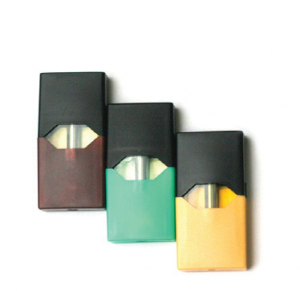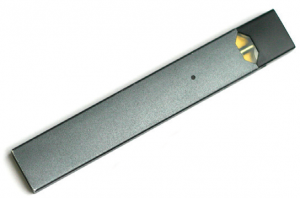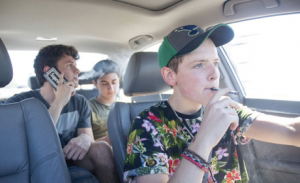Generation after generation, kids are into the “it” thing of the moment. Whatever is trendy, the kids want. Whatever is popular, the kids do. But as we know, not everything that is “cool” is good for our kids — a point of contention for teenagers who cannot see past what seems to be mom or dad impeding on their social lives. Music, fashion, food, technology, and unfortunately, yes, recreational drug, are topics which should not be taken for granted — especially when there’s something called a “Juul” (pronounced “jewel”) around.

THE JUUL
It’s a tobacco-less vape, a sleekly designed ultrasonic atomizer with a battery-powered cartridge. It’s basically an e cigarette disguised like a flash drive, and it’s firing up a whole new wave of young smokers.
The Juul’s cartridge delivers a vaporized form of nicotine liquid solution, available in flavors teens like. Only, it’s not harmless. According to the Center on Addiction, vaping doesn’t produce tobacco smoke, but rather an aerosol — often mistaken for water vapor — consisting of fine particles. Sounds harmless enough, but that vapor contains toxic chemicals, many which have been linked to cancer as well as respiratory and heart disease.
THE RAGE
Kids as young as grade school through high school have taken on Juuling — but why and how? Reasons vary. One powerful reason is that it’s trendy. From the sleek colorful packaging, resembling a simple flash drive, to how social media glorifies the product, to the desire to just be cool, kids are Juuling — and getting hooked in the process. Meanwhile Truth Initiative — America’s largest non-profit dedicated to eradicating tobacco use — says just one Juul cartridge contains 20 cigarettes worth of nicotine and more chemicals than any other e-cigarette out there, just to give some perspective.
According to Truth Initiative, before Juul was introduced in 2015, the most popular e-cigarette product contained nicotine strengths of between roughly one percent and 2.4 percent. When Juul debuted, its pods contained 5 percent of nicotine strength. This high potency is literally creating an epidemic of dependency among the kids who engage in vaping.

THE ACCESS
It has been reported that older teens are buying Juul pods in bulk during nonchalant convenient store transactions and then selling cartridges to peers. But President Trump signed a ban on flavored e-cigarettes last fall and now the sale of fruity and mint-flavored vape cartridges are banned. Still, kids can purchase Juuls and other vaping products online, and all parents know that teens are experts at finding loopholes in systems.
“E-cigarettes and Juul in particular, have become an epidemic among high school-age students,” says Jayson Roland, M.D. of TriHealth’s Queen City Pediatrics. “While cigarette smoking has steadily declined in this age group, electronic nicotine device use has skyrocketed,” he adds.
THE PROBLEM
What began as an alternative intended for adults who wanted to cut back on smoking, the Juul has now proven to be more harmful to smokers than their original habit.
According to the Center on Addiction, “Despite early optimism when these products first came on the market in the late 2000s, health advocates now recommend caution in using them in light of growing evidence suggesting that their risks — especially to young people — outweigh their benefits.”
There are many documented claims indicating how much harder it is to let go of a Juul addiction than a cigarette one. In an ongoing effort to protect the public, the U. S. Food and Drug Administration (FDA) has placed strong emphasis on warning consumers about the dangers of vaping. The FDA says that their cautionary campaign comes “amid more than 1,000 reports of lung injuries — including some resulting in deaths — following the use of vaping products. The FDA is working closely with the U.S. Centers for Disease Control and Prevention (CDC), as well as state and local public health partners to investigate these illnesses as quickly as possible.”
Julian Guitron, M.D., a general thoracic surgeon at The Christ Hospital in Cincinnati, says it wasn’t until the first vaping-related deaths were reported in late 2019 that the problem received national attention.
“We have seen an alarming increase in the use of vaping among high school students,” Guitron says. “The CDC and FDA launched full-fledged investigations to determine what element of the vaping products was responsible for the severe lung damage found in previously healthy teens,” he adds.
It is evident that Juuling is a widespread societal issue — and one that’s become too close for comfort. Although the legal age to smoke/vape or purchase tobacco products was raised to age 21 in the state of Ohio and Kentucky, this doesn’t stop teens and kids from gaining access to it.
HELPING YOUR CHILD
Create a Safe Space — Open dialogue can help tackle your kids’ troubles. Focus on simple questions that prompt transparent conversations, such as, “How was your day?”; “Anything new you want to share?”; “How are you feeling?”; and “Are you OK?” These are warm invitations that help breakdown any strongholds your child may have with being honest about vaping. Of course, all kids and teens are different; what may work for one may not work well for the other. Understand your child and know what approach works best for them; and of course, keep an eye out for the signs and take action.
Monitor Behavior and Peers — No secret, recreational drug use is of social influence. Pay close attention to how your kids alter their behavior around their friends, and the introduction of new friends who may have prompted “new personality traits” which explicitly go against the positive attitude you’ve worked to establish. Changed behavior means something in their environment needs to be adjusted. One way to combat the peer-induced effect is to create a pact with other parents. Agree to supervise all leisure and interactive gatherings, reviewing and removing any questionable gadgets that may be vaping related.
Communication and Education — A general consensus among parents, educators, coaches and others that vaping is dangerous and unacceptable can be helpful for your child. Then, if your child still chooses to use e-cigarettes out of rebellion, you can demonstrate compassion by intervening to help get at the root of his problematic decision-making. Seek help if necessary and stay involved to avoid addiction.
“It is a challenging situation,” says Guitron, “but the ‘news of the day,’ where previously healthy teens have died because of vaping, should provide parents with a starting point to educate and encourage their kids not to pick up the habit,” he says.
FACTS
• one Juul pod = 20 cigarettes worth of nicotine
• e-cigarettes are smoke-free, but not all are nicotine-free even though some claim to be
• nearly 95% of regular smokers start by the age of 21
Source: truthinitiative.com






